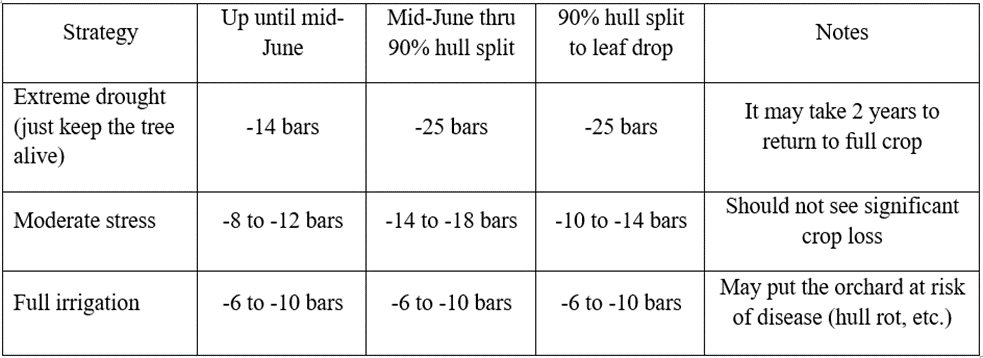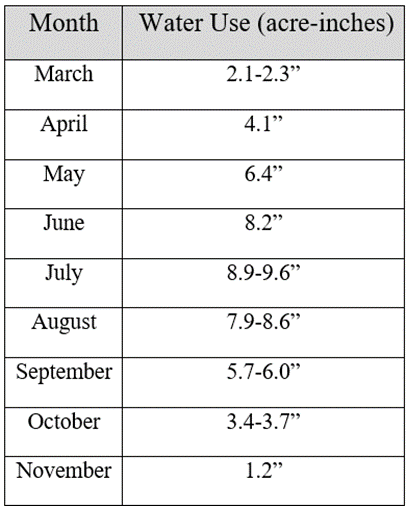Franz Niederholzer, UCCE Orchard Systems Advisor, Colusa and Sutter/Yuba Counties
Katherine Jarvis-Shean, UCCE Orchard Systems Advisor, Sacramento, Solano and Yolo Counties
Luke Milliron, UCCE Orchard Systems Advisor, Butte, Glenn, and Tehama Counties
Curt Pierce, UCCE Water Resources Advisor, Glenn, Tehama, Colusa and Shasta Counties
Record low temperatures on February 24 severely reduced nut set and limited almond yield across thousands of acres of orchards in the Sacramento Valley. To bring the remaining crop to market, and to ensure good crop potential for next year, growers and CCAs must strive to maintain orchard health – likely with limited water availability. The following are our best suggestions for the season, given our experience and UC research results.
Water is one of the key inputs to maintain tree health and future production, even in orchards with major crop loss from frost damage. Crop loss does not reduce almond orchard water demand very much (trees will use roughly the same amount of water with or without a crop). UC research with peaches, a crop closely related to almonds, validated this. Low cropload only reduced tree water requirements by ~ 10%, a relatively small amount compared the precision expected when executing most irrigation plans. For many growers this year, the challenge will be how to optimize limited water supplies (compared to full irrigation) to support the current crop and/or allow the tree to grow and develop flowers on the new growth for next year.
Water stress during different times of the season shows up in different ways. Early season water reductions from March through early or mid-May that result in mild to moderate water stress may reduce shoot growth, reduce external hull and shell size, and may or may not impact root growth. In some instances, root growth may respond to better aeration if the water cutback is not severe. Generally, withholding water early in the season is likely to have less impact on production compared to higher and more sustained water stress later in the season and may prove particularly beneficial if the water saved can be used later in season during June through August and early September. Irrigation reductions made later, roughly between mid-May and harvest, may result in nuts that are smaller in size, weight and have more shrivel. If irrigation is not resumed after harvest, severe crop reductions can occur the following year as flower bud development is harmed by extreme water stress.
Extreme water stress can mean more than lost yield this season. Flower buds for next year’s crop start forming around hull split (~July) and the process continues through September. Severe under irrigation, this season, will reduce flower bud initiation this year and crop next year, even if full irrigation is applied next year.
What does the research tell us about the “best” irrigation practices with less water? One strategy is to apply only a proportion of crop ET estimates that reflects the limited amount of water available and apply it consistently throughout the season across all of the phases of tree and nut development. This is a research-proven strategy to maintain tree health and production as much as possible depending on water limits. The cutback can be made by either extending the days between irrigations and/or decreasing the run time for each irrigation. For example, if supplying full ET involved irrigating for 24 hours every six days but enough water is only available to supply 75 percent ET, then a couple of options would be to extend the days between irrigation from seven to nine or ten days or continue to irrigate weekly but reduce the run time from 24 to 18 hours per week. If the current crop is lost, then under-irrigations during the nut development period are less of a concern and larger reductions in applied water may be possible. Hopefully, there is enough water available to irrigate at least 60% of ET
Another approach to irrigation scheduling under limited water availability is using a pressure chamber to schedule irrigations, possibly allowing for even more effective utilization of limited water as this approach directly measures tree water status. An orchard may use less water through a season if irrigation is based on current water stress compared to some percentage of predicted water use under full irrigation conditions. See the tables below for general pressure chamber and irrigation volume targets by growth stage and stress-level tolerance. Note, however, that tree stress levels returning pressure chamber readings in the range of -14 to -18 bars will likely stop shoot growth and limit canopy growth of young blocks. Indeed, all our recommendations are made assuming mature orchards (>7th leaf or 70% canopy coverage). Younger orchards should be irrigated more conservatively to encourage sufficient establishment and continued development.
The irrigation strategy that works best for an operation may come down to where the water comes from. If district water is used and delivery timing and amount must be requested, then ET-based irrigation (using historical ET levels) maybe the best way to go. On the other hand, using plant stress measurements (pressure chamber) and on-demand (well water) irrigation maybe the best way to limit water use and maintain orchard health and productivity for 2023 and beyond.
Individual farming operations must decide the best course for the year depending on crop load, orchard age and water availability plus addition factors unique to that business. Excellent, free resources for dealing with drought conditions in almond production are available at:

General target pressure chamber readings for different irrigation strategies.* *Sources: anrcatalog.ucanr.edu/pdf/8515.pdf ; anrcatalog.ucanr.edu/pdf/8503.pdf

Monthly mature almond orchard water use (acre-inches) ranges for the Sacramento Valley based on 30 year average data from CIMIS. These data show the average amount of water a mature almond orchard will use if water availability is unlimited (100% ET). Current year data will vary and are available at: sacvalleyorchards.com/et-reports.



Leave a Reply